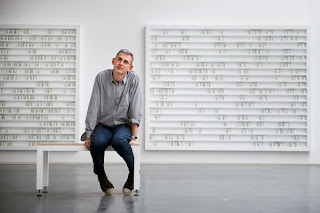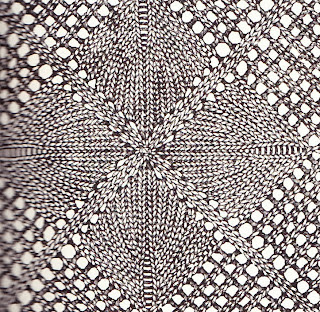Looking at this image, I couldn’t help thinking that the
wall of pots looked an awful lot like a close-up of rows of knitting:
And that connection reminded me of something I read several
years ago in Shaun McNiff’s Trust the Process, a study of creativity
addressed to visual artists. In the chapter
“Karma of Simple Acts,” McNiff advises artists to “experiment with making
artworks that require the repetition of small gestures over extended periods of
time.” Mc Niff suggests that this
technique can help overcome the fear that a large blank canvas can represent,
and also observes, “the process of
building a picture from thousands of strokes also gives me the opportunity to
carefully watch how a composition emerges.”
Repeating small gestures over extended periods of time is what
we knitters do. Although many creative activities require repetition of
gestures, whether in playing a musical instrument, practicing a dance routine,
or spelling out words, in most cases the component gestures disappear in the
final product. But in knitting, each
tiny seed is visible in the finished product. While a shirt is cut out of a
large piece of cloth, a sweater is created by placing one tiny loop through
another tiny loop, over and over again.
Naturally, as we hook one tiny loop inside another, we watch
how our “composition” emerges. The
process of creating a knitted garment is so slow and incremental that we can
make the subtlest of adjustments as we go.
We can shape and re-shape, we can turn a curve into an angle or a
straight line, we can meld and smooth as we go.
Drawing two stitches together makes a tiny concavity; turning an
additional loop into a new stitch makes a tiny cup. The repetition of miniscule elements means
that knitting in amazingly sensitive to the maker’s will.
In the same way, I’m sure Edmund de Waal sees miniscule
variations in his collection of vessels, as each one takes on its individual
character, while a product of the same series of gestures. I’m sure that he sees his own mood, his own
degrees of awareness reflected in each one, just as a knitter observes tiny
variations in her gauge from row to row.
There’s an immediate fascination for multiple versions of
the same form, especially when the forms are handmade, and we see similarity
coexisting with difference. In the same way as the display of de Waal’s vessels,
a knitted scarf or shawl offers the pleasure of a field of identical,
heart-shaped elements with tiny variations apparent to hand and eye.
As knitters, we have an immediate key to a creative portal,
as we repeat tiny gestures, building something beautiful and useful as we go.
By the way Edmund de Waal is also a gifted writer. His family memoir, The Hare with the Amber
Eyes, is a delightful book that has sold millions of copies through
readers’ word-of-mouth endorsements.)


No comments:
Post a Comment